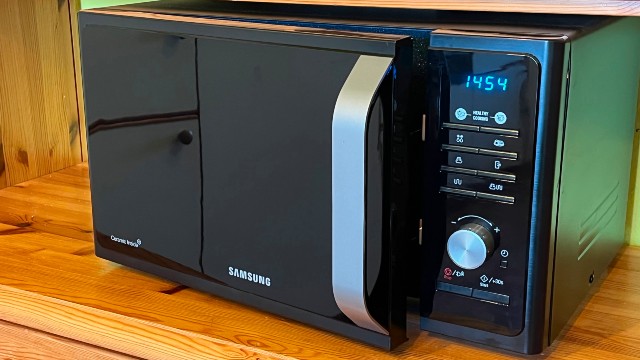Want to share feedback? Contact us.
Just like any appliance, your handy microwave will eventually stop working. When that time comes, you should consider repairing or replacing it.
So which is cheaper, fixing your old microwave or buying a new one?
Here’s When You Should Repair a Microwave (And When You Shouldn’t):
Microwave repair typically falls on the lower end of the appliance repair costs. However, if you have a basic model that costs less than $100, a replacement should be more cost-effective. Repair is the better choice with mounted microwaves and special features costing thousands.
How Much Does It Cost to Repair a Microwave on Average?
The average cost to repair a microwave is about $150, but the price can range from about $50 to $400. Depending on the brand, this should already include both labor and parts replacement.
If your microwave includes a warranty, the cost for repair should be less. The same applies to other discounts your service provider may offer to members.
In some cases, you may need to pay for replacing microwave parts on top of whatever labor fees are necessary to complete the repair.
This material cost can be as little as $5 for a new lightbulb or $400 for a microwave door.
The most common repairs for microwaves are minor ones like replacing glass trays or the more significant ones like changing the magnetron.
Prices for these replacements should already include payment for parts and labor.
If the problem with your appliance with the diode, the semiconductor that converts alternating current to direct current, you need to pay between $55 to $125 for repairs.
Meanwhile, replacing the turntable and power cord in your microwave may cost you between $60 to $200.
Glass trays and handles may be the most manageable parts to replace, but replacement can still charge you between $80 to $180.
As for the magnetron, the oscillator that generates heat that cooks your food, you will need to shell out up to $200.
If your microwave does not require part replacements, you will only be paying for labor. This typically costs between $50 and $100 per hour.
You should pay significantly less if you decide to take your appliance to a repair company, but this may mean waiting for service a little longer.
Because of their usual long line of clients, repair companies need several days to get back to you for a complete repair job.
However, this cannot be helped as you need a professional to wire a power cord or put on a new turntable motor.
You should always ask for a price estimate when contacting a technician or a repair company. This means checking if mileage is already part of the total cost.
The mileage fee is when you opt to have the specialist go to you for at-home repairs.
If you prefer to bring your microwave to the appliance repair shop and have it looked over there, that is your choice.
What Factors Should You Take Into Consideration Before Repairing Your Microwave?

You need to deliberate on several things when considering repairs for your microwave. Upkeep can cost you a lot of money, so you must exercise your best judgment should you decide to take them on.
One important factor is your appliance’s age. Most microwaves are designed to last eight to 10 years. If your unit is within this time frame, it is probably time to buy a new one.
The brand and model of your oven are also major considerations.
Expensive models that cost upwards of $1,000 are costlier to replace, so paying a few hundred for repairs should not bother you. One example is over-the-range microwaves.
If you have a microwave installed above the gas range or any area in your home, repair should be a more viable option.
Microwaves come in various sizes. If you are not careful in choosing, your new appliance may not fit the space where your old one was mounted.
Other home installation models also have functions tied into your house’s exhaust system since they operate as microwaves and exhaust fans for the stove. Replacing them with any model of the same size should not be easy.
On the other hand, a lower-end unit that costs around $300 brand new is probably a better deal than paying the $150 fee for the average repair.
If you own one of those older, cheaper models, it may be time to let them go. The repair money you will spend to keep them on life support for years may end up costing more than the unit itself.
Inexpensive models also tend to have a shorter lifespan. Once they show signs of breakdown, there is no use reviving them.
Another consideration is the amount of repair needed for your appliance. Some fixes are relatively straightforward, making repair the better choice.
Surface-level problems like scratches in the paint or cracks in the door should be easy to resolve.
If the problem involves only a single component, like a broken door handle or glass plate, the repairs are often worth it. These parts are pretty easy to obtain, so repairs should be simple.
Minor malfunctions like a wobble in the roller guide are reasonably easy to handle. What you have to be on the lookout for are issues related deep in the microwave’s integral systems.
For complicated and requiring multiple stages of resolutions, repair may not be worth your money and time.
The cost and availability of the replacement parts should also be taken into account.
Some components of the older microwave models may no longer be readily accessible today. If this happens, replacing the entire unit may be your only choice.
Where Can You Repair a Microwave?
For microwave repairs, you can either have it checked by authorized repair shops or by the local repair services in your area.
Before looking for one, you should check if your appliance is still under warranty or not. If it is, use your perks to save money on repairs.
Appliance stores have limited shops authorized to handle warranty repairs, so your options may be limited. These shops also tend to have lower ratings from customers. When you choose, be sure to do extra background checks.
You should ask how much the company charges for service calls during the consultation.
Some repair shops use either a flat-rate schedule or a time-and-materials basis for their services. Since hour rates vary considerably, remember to ask what that rate is.
Asking for a written estimate before proceeding with repairs also helps your decision-making.
You may likewise opt for the local repair services near you. Often, they offer lower rates, but their service quality is lower than more prominent competitors.
As with authorized repair shops, be sure to inquire about rates. In some cases, however, there is no way to determine the repair cost until the technician has checked your appliance.
Repair technicians often carry common replacement parts, so you can pay for the material and labor in one sum.
If the parts are not on hand, they may give you a quote on the component needed, or you can buy them on your own.
Local appliance services also offer home service, so you do not need to bring your microwave to their shops for consultation.
How Much Does a New Microwave Cost?
If the estimated repair cost is almost half the price of your appliance when you first bought it, you should consider replacing it.
On average, a microwave can cost between $100 to $600 depending on size, features, type, and brand.
Meanwhile, installation costs can be between costs $100 to $400.
When choosing a microwave, consider the type and features you need in your appliance.
Countertop microwaves do not require installation, so you only need to shell out money during a purchase.
They are considerably less expensive than over-the-range and built-in models, with a starting price between $50 and $150. This cost can balloon to $1,000 if you end up choosing the high-end units.
This type of appliance, however, typically comes with fewer features. Top brands tend to have more advanced models, like those with convection-cooking features.
For over-the-range microwaves, you will need to pay between $150 to $600 on average. The higher-end units can cost you up to $1,800.
With this type of appliance, you need professional installation since they require a precise fit in your chosen space.
Prices for built-in microwaves can climb up to $2,000, depending on size and features. Just like over-the-range models, they need installation by a professional.
You can save counter space with microwave units like these since they are fixed and blended into the wall or cabinetry.
You may also shop by brand if that is what you prefer. Top brands like LG and GE offer economically priced microwaves, with starting prices from $80 to $130.
They also have higher-end units that can cost you upwards of $3,000.
With top brands, appliances are usually made of fingerprint-resistant stainless steel rather than aluminum, so they are more durable and cost-effective.
What to Do With Your Old Microwave?
Getting rid of your old microwave is more complicated than you think. It is not as simple as tossing it in the trash.
Depending on the city where you live, there are rules on properly disposing of microwaves.
Some cities allow throwing old microwaves into the dumpster as long as you have permission to use them. Others consider the appliance “e-waste” with special rules on disposal.
If you do not want to end up paying a fine, you should check out these rules on your local government’s website.
There are several places where you can take your old microwave if the dumpster is out of the question.
One site is the local landfill. Most landfills will have specific bins for the appliance of e-waste.
You should also check if your city has a bulk pickup day. Putting out large items such as microwaves with the regular trash is allowed during this date.
Another option is to give your old microwave to a donation or thrift store. If the appliance still works, it is better to have someone else use it before it retires for good.
Recycling is the most eco-friendly way to dispose of your old microwave.
Many parts of a microwave oven are recyclable. Plenty of stores will accept your old appliance for free or for a small fee.
Your first choice should be e-waste recycling centers. They have trained professionals who will safely take apart your appliance and sort out the useful components.
You may also bring it to the nearest electronic store or appliance dealer in your area. These places try to recycle what they can and use the salvageable parts for their own projects.
Sending your old microwave back to the manufacturer may also be your best bet. If your appliance is from a well-known brand, you can even do this for free.
Some companies will shoulder the shipping cost to recycle your unit correctly.
Sources:
